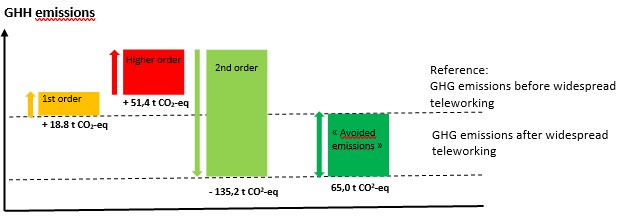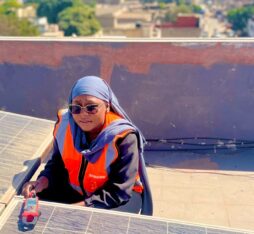
Climate emergency and digital
According to the IPCC*, implementing rapid and drastic action to reduce GHG emissions is the number one environmental emergency [1]. To respond to this urgency, the Paris Climate Agreement*, adopted in 2015, includes the objective of significantly reducing global GHG emissions so as to limit global warming to 2°C above pre-industrial levels [2].
How can we assess the impact of teleworking on greenhouse gas emissions?
According to the Shift Project [3], [4], the digital sector accounts for 2.9% to 3.5% of global GHG emissions. These figures may seem modest, but the digital sector’s share of GHG emissions is increasing year on year. Controlling and then reducing the carbon footprint of the digital sector represents a major challenge for the years to come. Many telecoms operators have already committed to achieving carbon neutrality* by 2040. Examples include Orange [5], Vodafone [6], British Telecom [7], Telefonica [8], Deutsche Telekom [9], Telenor [10], KPN [11], Telecom Italia Mobile [12] and MNT Group (Mobile Telephone Networks) [13]. Telia is even aiming for carbon neutrality as early as 2030 [14]. The main ways in which operators are aiming to achieve this goal are by measuring and reducing their carbon footprint, changing certain practices, technological advances and carbon offsetting*.
Digital technology, now indispensable for communicating, working and consuming, is perceived in a paradoxical way. On the one hand, it is criticized as part of the problem, due to the growing material and environmental footprint of digital infrastructures and terminals. On the other hand, digital technology is presented as perhaps part of the solution, with a growing number of economic, social and scientific organizations relying on digital technologies to respond to certain challenges, notably climatic and environmental.
The obligation for European companies to publish their carbon footprint
For companies, the assessment of GHG emissions is already mandatory in over 40 countries [15]. In Europe, the Corporate Sustainability Reporting Directive (CSRD, EU Directive 2022/2464 [16]) requires all European companies with more than 500 employees, sales of €40 million or balance sheet value of €20 million (these thresholds will be gradually lowered after 2024) to produce a standardized sustainability report, starting in 2024. This standardized sustainability report uses indicators to describe how the company integrates the principles and criteria of sustainable development* both internally and in its external actions. In particular, in the section of this report dedicated to climate change, companies will be required to present their carbon footprint*.
A company’s carbon footprint is broken down into three scopes:
- Scope 1 covers GHG emissions emitted directly by the company as a result of its own activities (e.g. emissions from heating its premises or from the vehicles it owns);
- Scope 2 corresponds to indirect GHG emissions induced mainly by the purchase or production of electricity in general;
- Scope 3 covers all the company’s other indirect emissions, i.e. those not directly associated with the manufacture of its products and services: upstream, the carbon footprint of its suppliers’ and partners’ products and services; downstream, the use of its products and services, limited however to the life cycle of products and their energy consumption, which leaves aside the other consequences of their use. Scope 3 is often the largest part of a company’s GHG emissions.
A methodology for assessing the impact of ICT solutions usage on user’s activity GHG emissions.
In December 2022, the ITU-T approved a methodology to assess the impact of the use of an ICT solution on GHG emissions, as an international reference for UN signatory states committed to its application. This method makes it possible to measure the overall impact (which can be positive or negative) on a third party’s own activity of implementing an ICT solution from the point of view of GHG emissions; this impact is often called “Pillar B” to distinguish it from the “Pillar A” made up of the three scopes (1 to 3) of the company supplying the digital solution.
Recommendation L.1480 [17], of which Orange was one of the contributors, provides an exhaustive auditable result of the GHG emissions generated or avoided by the user’s use of the solution.
The methodology is based on taking into account all the effects of the ICT solution studied, described in a consequence tree:
– The so-called first-order effects induced by the digital solution. For example, in the case of telecommuting, these are GHG emissions due to the purchase of terminals made necessary by telecommuting (e.g. purchase of a second monitor or printer at the teleworker’s home), or GHG emissions from the networks used to implement the digital telecommuting solution;
– Second-order effects, induced in relation to a historical reference situation, without any acceleration in the use of telecommuting (as in the case of Atalante). These include, for example, the effect of changes in teleworkers’ travel patterns on GHG emissions (e.g. elimination of certain home-work journeys), or the maintenance of journeys previously made on the home-work route (shopping, sporting activities, car-pooling, etc.);
– Higher-order effects, linked to changes in behavior induced by the use of the telecommuting solution, for both employees and employers. These may include working some days from a second home, taking advantage of reduced commuting times to take up a new activity (sport, etc.), employees relocating because of telecommuting or, more generally, all rebound effects, etc. Other examples include shared offices set up by the employer as a result of the widespread use of telecommuting, enabling a reduction in the surface area of company premises, or the reuse of financial benefits;
The assessment of all these effects relates to the specific activity of the user of the digital teleworking solution. It therefore always concerns a particular use case, for example the implementation of telecommuting on a site, for a company and its effect on its own processes. In this example, the impact of telecommuting on GHG emissions will vary according to the site studied, each site having its own characteristics (location, size, availability of public transport, number of employees, etc.), and it will also vary according to the company studied, depending in particular on its sector of activity.
The L.1480 methodology proposes three levels of measurement, depending on the precision required: simplified for an initial estimate, intermediate for decision-making between peers (companies), and full for external communication.
It also defines scaling rules for assessing the impact in terms of GHG emissions, for example aggregated over its users, or according to a particular sector of activity of said users.
An experiment at the Orange Atalante site in Rennes
Orange has implemented the full measurement level of the above-mentioned ITU-T methodology in the specific case of telecommuting implementation at its Orange Atalante site in Rennes, on a base of 687 employees. This work was the subject of a paper [18], presented in June 2023 at the EuCNC & 6G Summit 2023 (European Conference on Networks and Communications) on the theme “6G for a Green and Digital transition”.
Assessing the overall effects of implementing telecommuting at the Atalante site required the collection of extensive data from the Orange Information System and a survey of site employees (118 complete responses, i.e. 17% of site employees). This data enabled us to determine :
– The purchase of terminals (by Orange or by employees) made necessary by teleworking (e.g. the purchase of a monitor, a second computer or a printer for the home of certain teleworkers);
– Employee travel (journeys made, means of transport used, types of vehicle used, etc.), as well as changes in travel caused by teleworking (elimination of certain home-work journeys, etc.);
– The impact of telecommuting on employees’ homes (heating the homes of certain employees at certain times, made necessary by telecommuting, or the fitting out of an office for telecommuting by certain employees at home, the extension of the home, etc.);
– Other changes in employee behavior induced by telecommuting (e.g. teleworkers working from their second homes, employees moving house thanks to teleworking, etc.).
The reduction of working surfaces by “Flex Office” – which, according to ADEME, could contribute half of the reduction in GHG emissions (excluding higher-order effects) – was not envisaged during the study by Orange Atalante site management, and has therefore not been taken into account.
These observations were then translated into CO2-eq, according to the specific emission factor* of the associated goods or services.
This experiment on the impact of using a digital teleworking solution on GHG emissions, carried out on the Orange Atalante site, enabled us to assess the following effects over one year (see illustration below):
- 1st order effects (effect on GHG emissions linked to the existence of the digital solution) :
+ 18,8 tonnes CO2-eq
This means that, on the Orange Atalante site, over one year, the implementation of the digital teleworking solution emitted 18.8 tonnes CO2-eq.
– 2nd-order effects (effects in the transportation and building sectors):
– 135,2 tonnes CO2-eq
In other words, at the Orange Atalante site, over one year, the implementation of teleworking has reduced GHG emissions from transport and buildings by 135.2 tonnes CO2-eq, mainly thanks to the reduction in emissions from the use of private cars by employees (- 182.9 tonnes CO2-eq).
– Higher-order effects :
+ 51,4 tonnes CO2-eq
Overall, this experiment showed that the widespread use of telecommuting at the Orange Atalante site has saved 65.0 tonnes of CO2-eq over one year (year with action: 2022)

This study led to :
1) corroborate previous results, notably those published by ADEME [19], [20] about:
– first-order effects (carbon footprint of the solution itself) ;
– and deviations from the historical reference situation (without telecommuting or with less telecommuting);
2) measure for the first time the higher-order effects resulting from the use of teleworking, which reduced the positive result by a factor of more than two, from (135.2-18.8) =116.4 tonnes CO2-eq avoided, to (116.4 – 51.4) = 65 tonnes CO2-eq.
The assessment of higher-order effects, designed to account for all environmental effects in terms of GHG emissions, cannot therefore be overlooked.
The implementation of the ITU-T L.1480 methodology, which includes these higher-order effects, thus paves the way for a better understanding of the impacts, both positive and negative, of digital use, and for the establishment of a consensus on these consequences with a view to effective action to reduce GHG emissions.
ADEME: The French Agency for Ecological Transition, https://www.ademe.fr/en/frontpage/
Carbon footprint: A carbon footprint is a set of methods for measuring and tracking the quantity of GHGs that an organization (e.g. a company) emits as a result of its activity.
Carbon neutrality: carbon neutrality within a given perimeter is a state of equilibrium between man-made GHG emissions and their removal from the atmosphere by or through man. As the difference between emitted and extracted gases is then equal to zero, carbon neutrality is also referred to as “net zero” or “zero net emissions”.
Carbon offsetting: carbon offsetting involves a financier (company, local authority, individual, etc.) financing a project to reduce or sequester GHG emissions for which it is not directly responsible.
CO2 equivalent (CO2-eq): the CO2 equivalent of a GHG emission is the quantity of carbon dioxide that would have the same capacity to retain solar radiation and therefore cause the same warming of the atmosphere.
Emission factor: ratio between the quantity of greenhouse gases emitted by a product or service and the quantity of that product or service; expressed in CO2-eq.
Greenhouse gases (GHGs): GHGs are the gaseous components of the atmosphere that absorb infrared radiation emitted by the earth’s surface, thereby contributing to the greenhouse effect. The main GHGs are carbon dioxide (CO2), methane (CH4), nitrous oxide (N2O), ozone (O3) and various halogenated hydrocarbons (e.g. chlorofluorocarbons – CFCs). Each GHG has a different effect on the global warming of the Earth’s atmosphere, and its contribution is expressed in CO2 equivalent (CO2-eq).
ICT: Information and Communication Technologies, in french Technologies de l’Information et de la Communication.
IPCC: the Intergovernmental Panel on Climate Change is the intergovernmental body responsible for assessing the extent, causes and consequences of ongoing climate change.
IUT-T: The International Telecommunication Union (ITU), in french Union Internationale des Télécommunications, is the United Nations development agency specializing in information and communication technologies. The ITU-T is the sector of the ITU dealing with technical and standardization issues in telecommunications.
Neutralité carbone : en climatologie et en matière de politique climatique, la neutralité carbone à l’intérieur d’un périmètre donné est un état d’équilibre entre les émissions de GES d’origine humaine et leur retrait de l’atmosphère par l’homme ou de son fait. La différence entre les gaz émis et extraits étant alors égale à zéro, la neutralité carbone est également désignée par l’expression « zéro émissions nettes » ou encore « zéro net » (en anglais « net zero »).
Paris Agreement: the Paris Agreement, often referred to as the Paris Climate Agreement, is an international treaty on global warming adopted in 2015 concerning climate change mitigation, adaptation and financing. It is a legally binding international treaty. To date, 194 Parties (193 countries plus the European Union) have signed up to it
Sustainable development: sustainable development is a long-term approach to development that integrates environmental and social constraints into the economy.
***
By applying ITU-T recommendation L.1480, which takes into account all the effects that generate carbon emissions, Orange’s experiment showed that the widespread use of a digital teleworking solution at its Atalante site in Rennes avoided 65.0 tonnes of CO2-eq over one year, more than halving previous results that did not take into account all the effects (consequences).
Sources :
[1] Climate change: a threat to human wellbeing and health of the planet}. Taking action now can secure our future. IPCC, 28 février 2022
https://www.ipcc.ch/2022/02/28/pr-wgii-ar6/
[2] Report of the Conference of the Parties on its twenty-first session, held in Paris from November 30 to December 13, 2015
https://unfccc.int/resource/docs/2015/cop21/fre/10a01f.pdf
[3] Toward Digital Sobriety, The Shift Project, 2019
https://theshiftproject.org/wp-content/uploads/2019/03/Lean-ICT-Report_The-Shift-Project_2019.pdf
[4] Climate crisis: The unsustainable use of online video, The Shift Project, Juillet 2019
https://theshiftproject.org/en/article/unsustainable-use-online-video/
[5] Environmental commitment: net zero carbon emissions by 2040, Orange, 28 août 2020
https://www.orange.com/en/engagements/orange-s-commitment/to-the-environment
[6] Vodafone Group Plc Annual Report, 2022
https://investors.vodafone.com/sites/vodafone-ir/files/2022-05/vodafone-2022-annual-report.pdf
[7] BT Group plc Manifesto Report, 2022
https://www.bt.com/bt-plc/assets/documents/digital-impact-and-sustainability/our-report/report-archive/2022/2022-manifesto-report.pdf
[8] Telefonica, sustainability and innovation: Environment
https://www.telefonica.com/en/sustainability-innovation/environment/
[9] DT Group 2021 Corporate Responsibility Report, Managements & facts, 2021
https://www.cr-report.telekom.com/2021/management-facts/strategy/foreword
[10] Telenor annual and sustainability report, 2021
https://www.telenor.com/binaries/investors/reports-and-information/annual/annual-report-2021/Telenor%20Annual%20Report%202021.pdf
[11] KPN Integrated Annual Report, 2021
https://ir.kpn.com/download/companies/koninkpnnv/Results/KPN_Integrated_Annual_Report_2021.pdf
[12] Environment and circular economy, TIM Group
https://www.gruppotim.it/en/group/sustainable-future/environment-circular-economy.html
[13] MTN Group links remuneration of senior executives to ESG goals
https://www.mtn.com/mtn-group-links-remuneration-of-senior-executives-to-esg-goals/
[14] Telia Annual and Sustainability Report, 2021
https://www.teliacompany.com/globalassets/telia-company/documents/reports/2021/annual/telia-company-annual-and-sustainability-report-2021_1103.pdf
[15] A Global Look at Mandatory Greenhouse Gas Reporting Programs, World Resources Institute, 27 mai 2015
https://www.wri.org/insights/global-look-mandatory-greenhouse-gas-reporting-programs
[16] Directive (EU) 2022/2464 of the European Parliament and of the European Council of December 14, 2022 amending Regulation 537/2014 and Directives 2004/109/EC, 2006/43/EC and 2013/34/EU as regards the publication of sustainability information by companies
https://finance.ec.europa.eu/capital-markets-union-and-financial-markets/company-reporting-and-auditing/company-reporting/corporate-sustainability-reporting_en
[17] L.1480 “Enabling the Net Zero transition: Assessing how the use of information and communication technology solutions impacts GHG emissions of other sectors”}, ITU-T Study Group 5, 6 décembre 2022
https://www.itu.int/ITU-T/recommendations/rec.aspx?rec=15030
[18] Assessing How the Use of Teleworking Impacts GHG Emissions: A Study Case, juin 2023
https://ieeexplore.ieee.org/document/10188282
[19] ADEME, « Étude sur les effets rebonds induits par le télétravail » sept. 2020 https://librairie.ademe.fr/mobilite-et-transport/3776-caracterisation-des-effets-rebond-induits-par-le-teletravail.html
[20] ADEME « Évaluation de l’impact du télétravail et des tiers lieux sur la réduction des consommations d’énergie et des émissions de gaz à effet de serre et sur l’organisation des entreprises » sept. 2015 https://librairie.ademe.fr/mobilite-et-transport/3783-evaluation-de-l-impact-du-teletravail-et-des-tiers-lieux-sur-la-reduction-des-consommations-d-energie-et-des-emissions-de-gaz-a-effet-de-serre-et-sur-l-organisation-des-entreprises.html











